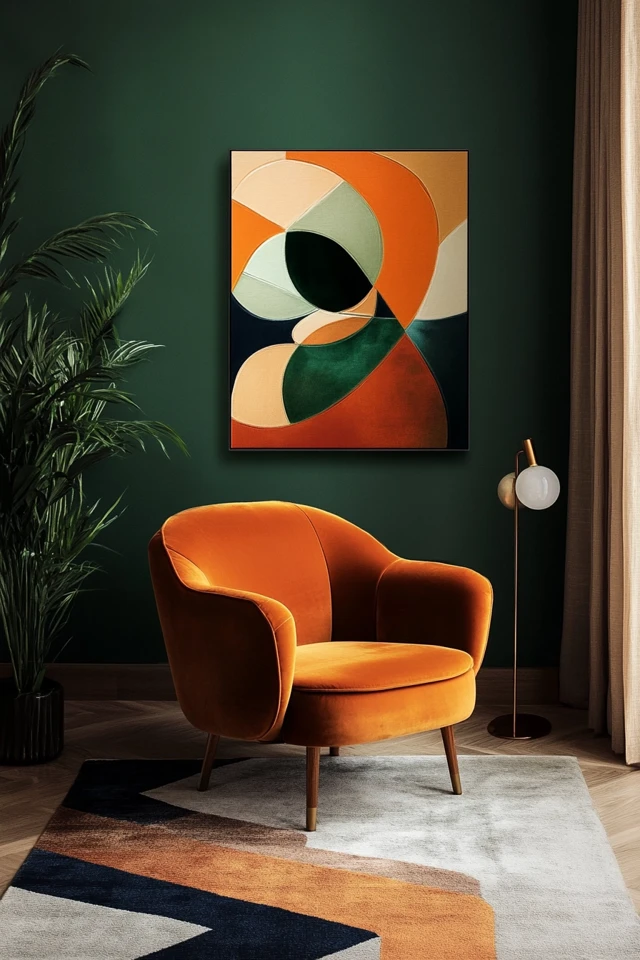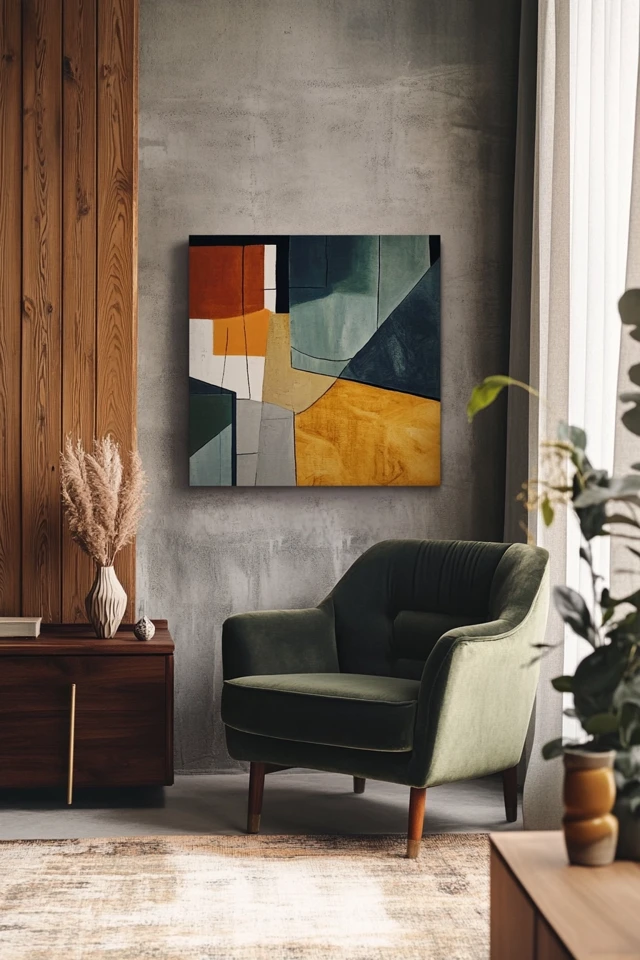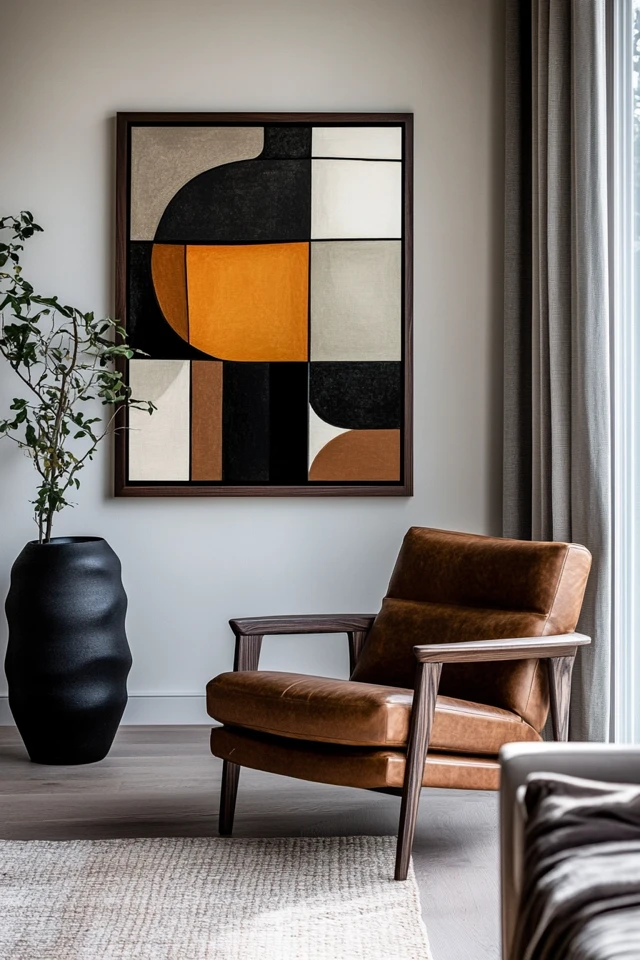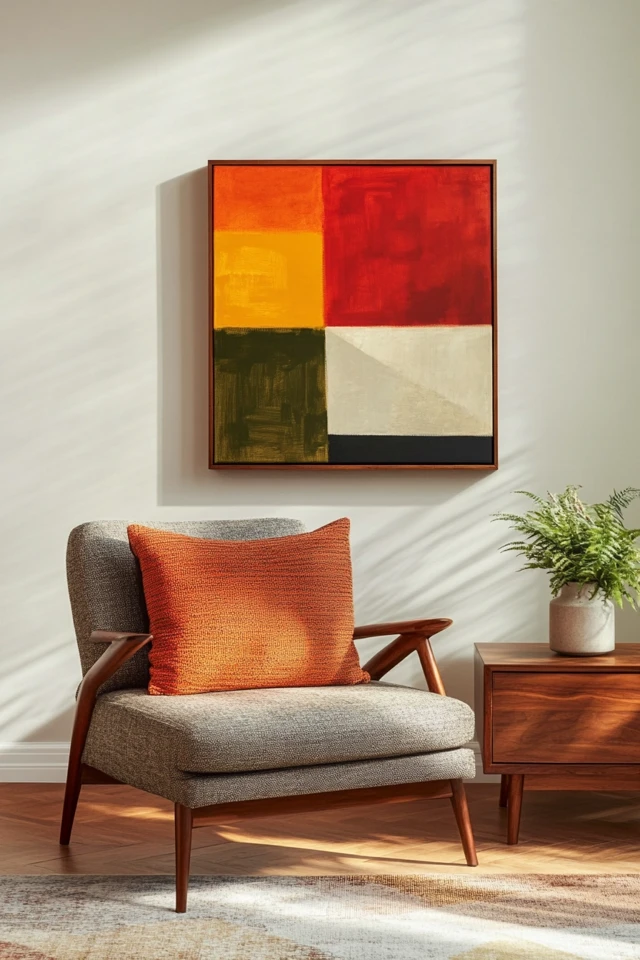Mid-century modern design is known for its clean lines, functional furniture, and timeless elegance. But there’s one design element that can elevate this aesthetic to an entirely new level: abstract artwork. With its bold colors, fluid forms, and expressive energy, abstract art beautifully complements the minimalist foundation of mid-century spaces, adding depth, personality, and visual intrigue.
I learned the power of abstract art firsthand while redesigning my own living room. The space was styled with quintessential mid-century pieces—walnut furniture, a retro area rug, and a sputnik chandelier. It was beautiful, but something was missing. Enter a large, abstract canvas with bold, overlapping shapes in mustard, teal, and rust. It completely transformed the room, tying together the color palette while injecting vibrancy and character.
In this guide, I’ll show you how to seamlessly incorporate abstract artwork into mid-century modern spaces, whether you’re working with a large living room, a cozy dining area, or even a small office nook.
Why Abstract Art Works in Mid-Century Modern Design
- Contrasting Elements: The expressive and freeform nature of abstract art offsets the clean, structured lines of mid-century furniture.
- Color Play: Abstract art allows you to introduce bold, retro-inspired hues that complement mid-century palettes.
- Focal Points: Abstract pieces serve as stunning focal points, drawing the eye and adding a layer of sophistication.
- Timeless Appeal: Just like mid-century modern furniture, abstract art has a timeless quality that transcends trends.
1. Choose Art That Complements Your Mid-Century Color Palette
Why It Works:
Abstract art can act as a unifying element in your space by tying together the colors used in your furniture and decor.
How to Do It:
- Look for pieces that incorporate retro-inspired hues like mustard yellow, teal, rust, olive green, and burnt orange.
- Opt for neutral-toned art (black, white, gray) if your space already has bold furniture or decor.
- Use the artwork as inspiration for your color scheme, pulling accent colors for throw pillows, rugs, or vases.
Pro Tip: Balance is key—if the artwork is vibrant and busy, keep surrounding decor more subdued.
2. Scale Matters: Make It Big
Why It Works:
Large abstract artwork creates a dramatic statement and prevents the space from feeling too minimalist or plain.
How to Do It:
- Choose a single oversized canvas or panel to hang above a sofa, bed, or dining table.
- Ensure the artwork fills about two-thirds of the wall’s width for proper proportion.
- Position it at eye level, with the center of the artwork approximately 60 inches from the floor.
Pro Tip: If you’re nervous about committing to bold colors, start with a black-and-white abstract piece for a sleek, understated look.
3. Gallery Walls for a Playful Touch
Why It Works:
Mid-century modern spaces thrive on creativity, and a curated gallery wall adds personality and dimension.
How to Do It:
- Combine small and medium-sized abstract pieces with other mid-century elements, like vintage posters or geometric prints.
- Use simple, minimalist frames (wood or metal) to keep the focus on the artwork.
- Arrange the pieces asymmetrically for a relaxed, artistic vibe.
Pro Tip: Include at least one piece with the iconic mid-century color palette to anchor the gallery wall.
4. Layer Art on Furniture for a Relaxed Look
Why It Works:
Instead of hanging every piece, leaning abstract artwork against walls or on furniture creates a more casual, modern vibe.
How to Do It:
- Place a framed abstract piece on top of a credenza, sideboard, or console table.
- Layer smaller pieces in front of larger ones for added depth.
- Pair the artwork with mid-century decor, like sculptural vases, table lamps, or books.
Pro Tip: Use this technique in spaces where you want a softer, more informal atmosphere, like a bedroom or home office.
5. Pair Abstract Art With Iconic Mid-Century Furniture
Why It Works:
The clean, geometric forms of mid-century furniture provide the perfect backdrop for abstract artwork.
How to Do It:
- Hang a vibrant abstract painting above a streamlined sofa or credenza to create a bold focal point.
- Pair sculptural furniture, like the Eames lounge chair or a Saarinen tulip table, with abstract art that echoes its shapes.
- Use abstract art to highlight architectural features, like a brick fireplace or wood-paneled wall.
Pro Tip: Let the art and furniture share the spotlight by keeping other decorative elements minimal.
6. Add Depth With Textured Abstract Art
Why It Works:
Mid-century modern design often incorporates a variety of textures, and abstract art with tactile elements adds another layer of interest.
How to Do It:
- Choose pieces with raised paint, collage elements, or mixed media for a dynamic look.
- Pair textured artwork with smooth mid-century surfaces, like glass, metal, or polished wood, for contrast.
- Use subtle lighting to highlight the texture, such as adjustable wall sconces or picture lights.
Pro Tip: Keep the color palette cohesive to avoid visual overwhelm when working with textured art.
7. Mix Bold and Subtle Abstract Styles
Why It Works:
Combining different styles of abstract art prevents the space from feeling one-dimensional.
How to Do It:
- Pair a bold, colorful painting with a more subtle black-and-white or neutral-toned piece.
- Use geometric abstract art alongside more fluid, organic shapes for variety.
- Distribute the pieces across the room to maintain balance and flow.
Pro Tip: Avoid overcrowding—stick to one or two bold statement pieces per room.
8. Use Abstract Art in Unexpected Places
Why It Works:
Adding art to overlooked areas injects creativity and personality throughout your home.
How to Do It:
- Hang a small abstract print in a hallway, bathroom, or kitchen for an unexpected pop of style.
- Use vertical abstract pieces in narrow spaces, like between windows or above a desk.
- Position abstract artwork on bookshelves or built-ins to break up the symmetry.
Pro Tip: Smaller pieces work well in these areas; save the large canvases for main living spaces.
9. Frame Abstract Art With Mid-Century Materials
Why It Works:
The right frame can enhance the connection between the artwork and the mid-century modern aesthetic.
How to Do It:
- Choose wooden frames in walnut, teak, or oak to echo the furniture.
- Use thin black or metallic frames for a sleeker, contemporary edge.
- Consider floating frames to give the art a light, airy feel.
Pro Tip: Avoid overly ornate frames, which can clash with the minimalist nature of mid-century design.
10. Layer Abstract Art With Lighting
Why It Works:
Lighting can transform the way abstract art looks, emphasizing its colors, textures, and overall impact.
How to Do It:
- Install picture lights above key pieces for a gallery-inspired touch.
- Use adjustable sconces or track lighting to highlight a larger collection.
- Position a floor lamp or pendant light near the artwork to enhance its presence.
Pro Tip: Opt for warm-toned lighting to bring out the richness of retro-inspired colors in the art.
Picture Gallery








Conclusion
Abstract artwork is the perfect complement to mid-century modern spaces, bringing energy, creativity, and personality to your home. Whether you’re making a statement with a large canvas, curating a playful gallery wall, or layering art with iconic furniture, the possibilities are endless.
The key is to find pieces that resonate with your style while enhancing the mid-century aesthetic. By thoughtfully incorporating abstract art, you’ll create a space that feels dynamic, timeless, and uniquely yours.
FAQs
1. What colors should I look for in abstract art for mid-century modern spaces?
Focus on retro-inspired colors like mustard yellow, teal, rust, olive green, burnt orange, and neutrals.
2. Can I mix abstract art with other art styles?
Yes! Mixing abstract art with geometric prints, vintage posters, or photography adds variety and interest.
3. How do I choose the right size artwork for my space?
The art should fill about two-thirds of the wall space above furniture, such as a sofa or bed, for proper proportion.
4. What’s the best way to hang abstract artwork?
Hang art at eye level, with the center of the piece around 60 inches from the floor. Use a level for precision.
5. Where can I find abstract art for mid-century spaces?
Check out Etsy, Saatchi Art, Society6, or local galleries for affordable options. Vintage shops often carry unique pieces as well.


